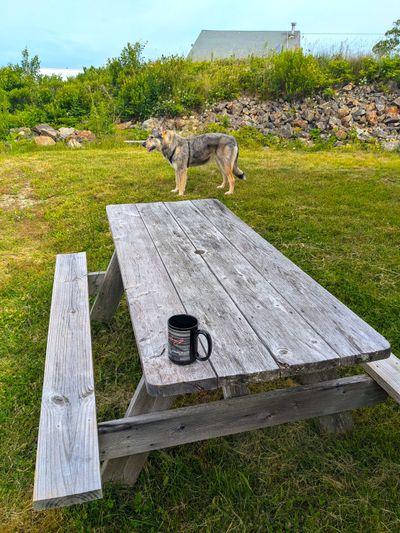Ask the Builder: How to protect exterior wood

Recently, my lovely wife and our 2-year-old American Dirus dog were on Mount Desert Island in Downeast Maine. We rented a tiny cottage just 12 feet from the shoreline of Bass Harbor. If you’re unfamiliar with this part of the USA, I can assure you it’s a harsh marine environment. Anything made from wood or iron that’s not protected from the sun and the sea will succumb to the elements and have a very short service life.
Early each morning, I took our dog out so she could relieve herself. I sat with a cup of coffee on a gray, weathered picnic table, watching the 11-foot ebb tide leave the bay. The ultraviolet rays of the sun, salt spray, rain and snow had tortured the table. Perhaps it was intentional, so the table matched the rustic, weathered appearance of the proud and tired cottage. If so, the property owner achieved the goal.
If this picnic table is not cleaned and sealed in a year or two, it will start to resemble the decking and handrail on the pier that extended out from the land just 30 feet from the table. Some pieces of the decking and railing had cracks as large as one-quarter inch. Raised summer-wood grain on the handrail was as sharp as a razor. These slivers of wood could cut your soft skin with little effort.
Allow me to expound on the mechanics of wood weathering. If you understand what’s going on, you’ll be much more inclined to take care of all of the exterior wood on and around your home. This includes decks, fences, siding, wood furniture, playsets and so forth.
UV rays are far more powerful than you might imagine. About 5% of them contain active photons. These photons resemble microscopic cruise missiles. When the photons strike any surface, they cause damage.
They’re so powerful that they can break atomic bonds of softer metals such as copper, zinc and lead. This is why copper can be used to protect asphalt shingles from decay. I covered that in my book “Roofing Ripoff,” but that’s a column for another day. Have you ever thought about why the galvanized roof panels on old barns begin to rust? Where did the zinc coating go? The photons blasted it apart, and the rain washed the zinc to the ground around the barn.
Knowing this, you can see how destroying wood is child’s play for UV rays. The rays break apart the bonds of the lignin in wood. The damage extends to the coloration of the wood. It’s why unprotected wood turns gray. The softer spring wood that’s lighter in color than the dark summer wood bands falls apart faster. Just as your skin needs sunscreen to prevent sunburn, so does all your exterior wood. Paint and pigmented sealers are very good wood sunscreens.
Water is the next demon that haunts your exterior wood. Wood will rot without protection from water. The picnic table I sat at each morning was probably constructed from lumber that had been infused with copper. Copper is a natural biocide. The fungi that cause wood rot can’t survive in the presence of copper.
Wood is an amazing material, but as with just about everything, it has an Achilles’ heel. It’s hygroscopic. This means the shape and size of wood change as the moisture content within it goes up and down. In other words, wood swells and shrinks. Metal doesn’t do this. This is one reason why the paint on your car never seems to peel, yet no matter what you do, you can’t seem to stop paint from peeling on all your exterior wood items. The swelling of the wood is so great the paint can’t maintain its grip.
Small checking cracks are the first things that develop on unprotected wood. These cracks are very small, about the width of a hair on your head. Checking cracks are the gateway to full-blown destruction. Each time it rains, the water enters the crack. The wood begins to swell and slowly starts to tear itself apart.
Repeated wetting and drying causes more wood fibers to break just as you can do by bending the aluminum tab on a soda can back and forth. Over time the crack gets bigger and bigger as water is allowed to get deeper into the wood. I know you’ve seen cracked exterior wood. The cracks can get so deep the entire piece of wood splits apart.
Now you know what to do. You need to stop UV rays and water from getting to your wood. UV protection is the easiest thing to achieve. Water penetration is far more difficult. Each piece of exterior wood must be completely coated on all sides and edges with paint or a sealer to prevent water infiltration.
This means if you’re building a picnic table like the one I sat on, you must cut all the pieces first and then paint or seal them before you assemble the table. You’re trying to make it impossible for water to get into the wood where one piece touches another piece. Most people won’t go to all this trouble. It’s the primary reason you see paint peel from exterior wood. Water is seeping into the wood in all the places where it’s not painted.
Subscribe to Tim Carter’s free newsletter at AsktheBuilder.com. Carter offers phone coaching calls if you get stuck during a DIY job. Go here: go.askthebuilder.com/coaching